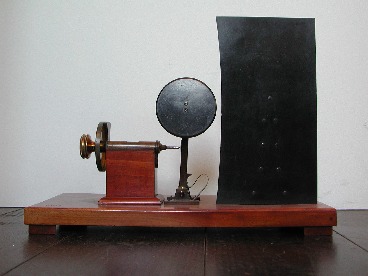

Observing the Venus Transit 2004
.... The "Black Drop"!
What is the "Black Drop"?
| The "Black Drop" phenomenon |
When timing the second and third contacts, you must pay attention to the "black drop" phenomenon. This effect has been known by observers since long and implies that Venus appears to be "stuck" to the limb of the Sun, as if with some kind of chewing-gum, see the illustration above. It makes it difficult to estimate the moment when the border of Venus' dark circle exactly touches the border of the Sun.
An old problem
| A Black Drop Training Machine : This intriguing device was used during the VT-1874 expedition by a team of Dutch astronomers to the French Ile de Réunion. It was set up a few hundred meters from the telescope. There is a white background behind it and with the screw to the left the round disk may be moved back or to the black curve at the right. It was used to practise measuring the 2nd and 3rd contact. The black drop effect also shows up with this device and it helped the astronomers to find their own personal error in measuring the contact times. This device is now in the exhibition "Venus achterna" (chasing Venus) in Museum Observatory Sonnenborgh in Utrecht. Photo kindly supplied by Robert Wielinga (Utrecht, The Netherlands). |
Sir Edmond Halley and other astronomers in the early 18th century believed that it would be possible for an experienced observer to time this moment with an accuracy of about 1 second; however, it turned out that because of the "black drop" effect, the timings could be wrong by up to 1 minute!
Observers in the 19th century were careful to prepare themselves for this problem and were successful in reducing the timing errors. Still, the achievable accuracy was limited by the "Black Drop" and values of the Astronomical Unit differed, when deduced from timing data obtained from different observers.
The cause of the Black Drop phenomenon
| The "Black Drop" at Different Optical Resolutions : The three rows demonstrate the way the "black drop" looks like at different optical "sharpness" - the sharper the images, the less dominant is the effect and the more correctly can the moment of the contact be determined. The time interval between two images in a row is 20 seconds. From an article by Dan Kiselman and Mats Löfdahl in "Populär Astronomi" (Juni 2004, Sweden). |
For a long time, it was not known what caused the "black drop". Various ideas were brought forward to explain it, including some kind of effect by Venus' thick atmosphere.
We now know that it arises mainly because of two effects:
- the limited optical resolution by the optical system used. The smaller (worse) the achievable optical sharpness is, the more prominent and disturbing is the "black drop", see the illustration above.
- the "limb darkening" of the solar disc, i.e., the brightness of the solar "surface" decreases towards the border
You may simulate the appearance of the "black drop" effect by almost pinching your thumb and forefinger against a bright background. When they approach each other, you suddenly perceive a "connection" between the two. This is nicely illustrated on a page in the VT-2004 Kids' Area
How to observe?
There is a rich literature about the "Black Drop" phenomenon; some links are given below.
Observers who obtain images can work on them later and then reduce the influence of the "black drop" phenomenon by clever image processing, e.g. by means of the VT-2004 facility set up at the Ondrejov Observatory (The Czech Republic).
This is not so for visual observers - they are confronted with the same problem as their predecessors at earlier transits. So how can they overcome this problem and obtain good measurements? Even if the achievable accuracy will of course depend on the equipment used, there are certain ways of improving the results.
There are different opinions about how to perform visual observations in such a way that the adverse effect of the "black drop" effect on the timing accuracy is minimized. However, it seems that the following advice given to observers of the 1882 Venus Transit by Simon Newcomb , one of the famous astronomers at that time (quoted from the article by Steven van Roode at this website, is still as good as any to be had:
"At each contact, start looking at the foretelled position of Sun’s limb about two minutes before the predicted time of contact, in order not to fatigue your eye. Just before interior contact at ingress, the Sun’s limb will be broken by the planet, and the Sun will show two fine sharp horns of light, gradually approaching each other to meet around the dark body of the planet. The moment of contact is regarded as the time when the sharp points of the cusps begin to meet. But the ends of these cusps assume a certain haziness and their ill-defined outline will often be wavy and diffused by the effect of atmospheric tremors.
The moment of interior contact at ingress is that at which light is about to glimmer all across the dark space between the cusps. Very generally there will be a period of several seconds during which the light will glimmer and disappear by turns. The middle of this period is that of true contact.
At egress, all the phenomena described above will recur in reverse order. As the planet is approaching interior contact at egress, the band of light in front of it, as it fades away, very gradually grows fainter until it is almost lost in vision. The time of interior contact is marked by the moment at which light entirely ceases to glimmer across the dark space formed by the approach of the planet’s limb to that of the sun. From the commencement of this darkening until its disappearance from view, there is a series of progressive changes, which may extend over a period of several seconds. Again, the middle of this period is that of true contact."
None of the participants in the observations of this year's transit can claim to be experienced in this kind of work! But try to think about these wise words from the past and maybe you will do better. In any case, you will get a feeling of the level of precision achieved by the VT-2004 observers in general when the value of the Astronomical Unit based on all the timings is calculated!
Links to information about the "Black Drop"
- Transit of Venus - Steve Roode's website
- The "Black Drop" Effect - Chuck Bueter's Venus Transit website
- Space Studies of the Black Drop Effect at a Mercury Transit - paper by Glenn Schneider, Jay M. Pasachoff and Leon Golub (October 2003; PDF)
- Basic article on the "Black Drop" phenomenon - by Italian astronomer Guido Horn d'Arturo (from 1922, written in Italian, here translated into English)
- Contributions to the VT-2004 Forum


